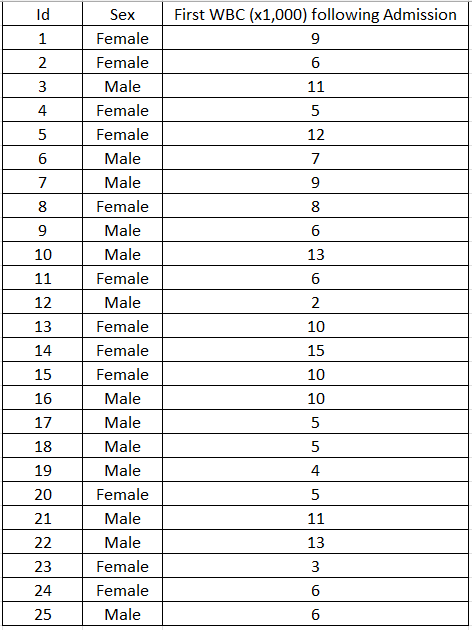(b) Compute a 95% CI for the mean white blood count (in thousands) (use the variable named "First WBC (x 1000) following admission") following admission. (Enter your answer using interval notation. Round your numerical values to two decimal places.) (6.18,8.94) x thousands (c) Compute a 90% CI for the mean white blood count (in thousands) (use the variable named "First WBC (x 1000) following admission") following admission. (Enter your answer using interval notation. Round your numerical values to two decimal places.) (6.42,8.70) x thousands
(b) Compute a 95% CI for the mean white blood count (in thousands) (use the variable named "First WBC (x 1000) following admission") following admission. (Enter your answer using interval notation. Round your numerical values to two decimal places.) (6.18,8.94) x thousands (c) Compute a 90% CI for the mean white blood count (in thousands) (use the variable named "First WBC (x 1000) following admission") following admission. (Enter your answer using interval notation. Round your numerical values to two decimal places.) (6.42,8.70) x thousands
MATLAB: An Introduction with Applications
6th Edition
ISBN:9781119256830
Author:Amos Gilat
Publisher:Amos Gilat
Chapter1: Starting With Matlab
Section: Chapter Questions
Problem 1P
Related questions
Question
100%
How do you find (b.), (c.), and (g.)??

Transcribed Image Text:(a) Compute a 95% CI for the mean age (in years). (Enter your answer using interval notation. Round your numerical values to two decimal places.)
(32.94, 49.54)
years
(b) Compute a 95% CI for the mean white blood count (in thousands) (use the variable named "First WBC (x 1000) following admission") following admission. (Enter your answer using interval notation. Round your numerical values to two decimal places.)
(6.18,8.94) x thousands
(c) Compute a 90% CI for the mean white blood count (in thousands) (use the variable named "First WBC (x 1000) following admission") following admission. (Enter your answer using interval notation. Round your numerical values to two decimal places.)
(6.42,8.70) x thousands
(d) What is the relationship between your answers to (b) and (c)?
The 90% confidence interval is wider than the 95% confidence interval since we are requiring more confidence.
o The 90% confidence interval is narrower than the 95% confidence interval since we are requiring less
confidence.
The 90% confidence interval is narrower than the 95% confidence interval since we are requiring more
confidence.
The 90% confidence interval is wider than the 95% confidence interval since we are requiring less confidence.
(e) What is the best point estimate of the percentage of males among patients discharged from Pennsylvania hospitals?
40
%
(f) What is the standard error of the estimate of the percentage of males among patients discharged from Pennsylvania hospitals? (Round your answer to four decimal places.)
9.7980
%
(g) Provide a 95% CI for the percentage of males among patients discharged from Pennsylvania hospitals. (Enter your answer using interval notation. Round your numerical values to two decimal places.)
(20.80, 59.20)
X %

Transcribed Image Text:Id
1
2
3
4
5
6
7
8
9
10
11
12
13
14
15
16
17
18
19
20
21
22
|
23
24
25
Duration of Hospital Stay
5
10
6
11
5
14
30
11
17
3
9
3
8
8
5
5
7
4
3
7
9
11
11
9
4
Age
30
73
40
82
60
47 Female
56
25 Female
43
50
4
22
32
36
69
Sex
47
Female
59 Female
Female
11
Male
19
67
Male
33 Female
41
Male
20 Female
Female
Male
Male
Male
Female
Male
22 Female
Male
Male
Male
Male
Male
Female
43 Female
Male
First Temperature Following Admission First WBC (X 1,000) Following Admission Received Antibiotic Received Bacterial Culture Service
99
98
99
98.2
98.5
96.8
99.5
98.6
98
98
97.6
97.8
99.5
98.4
98.4
99
99.2
98
97
98.2
98.2
98.6
97.6
98.6
98
9
6
11
5
12
7
9
8
6
13
6
2
10
15
10
10
5
5
4
5
11
13
3
6
6
No
No
No
No
No
Yes
Yes
No
No
No
No
No
Yes
Yes
No
No
Yes
No
Yes
No
No
Yes
No
No
No
No
Yes
No
No
No
No
Yes
No
No
Yes
Yes
No
No
Yes
Yes
No
No
No
No
No
No
No
No
No
No
Medical
Medical
Surgery
Surgery
Surgery
Surgery
Medical
Medical
Medical
Surgery
Medical
Surgery
Surgery
Surgery
Surgery
Surgery
Surgery
Surgery
Medical
Surgery
Surgery
Surgery
Medical
Surgery
Medical
Expert Solution
Step 1
Given data:

Trending now
This is a popular solution!
Step by step
Solved in 2 steps with 4 images

Recommended textbooks for you

MATLAB: An Introduction with Applications
Statistics
ISBN:
9781119256830
Author:
Amos Gilat
Publisher:
John Wiley & Sons Inc

Probability and Statistics for Engineering and th…
Statistics
ISBN:
9781305251809
Author:
Jay L. Devore
Publisher:
Cengage Learning

Statistics for The Behavioral Sciences (MindTap C…
Statistics
ISBN:
9781305504912
Author:
Frederick J Gravetter, Larry B. Wallnau
Publisher:
Cengage Learning

MATLAB: An Introduction with Applications
Statistics
ISBN:
9781119256830
Author:
Amos Gilat
Publisher:
John Wiley & Sons Inc

Probability and Statistics for Engineering and th…
Statistics
ISBN:
9781305251809
Author:
Jay L. Devore
Publisher:
Cengage Learning

Statistics for The Behavioral Sciences (MindTap C…
Statistics
ISBN:
9781305504912
Author:
Frederick J Gravetter, Larry B. Wallnau
Publisher:
Cengage Learning

Elementary Statistics: Picturing the World (7th E…
Statistics
ISBN:
9780134683416
Author:
Ron Larson, Betsy Farber
Publisher:
PEARSON

The Basic Practice of Statistics
Statistics
ISBN:
9781319042578
Author:
David S. Moore, William I. Notz, Michael A. Fligner
Publisher:
W. H. Freeman

Introduction to the Practice of Statistics
Statistics
ISBN:
9781319013387
Author:
David S. Moore, George P. McCabe, Bruce A. Craig
Publisher:
W. H. Freeman